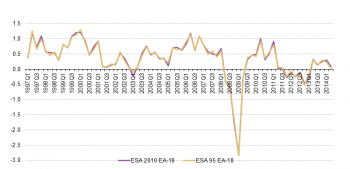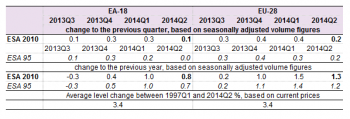Archive:Quarterly national accounts - main GDP aggregates ESA 2010
- Data from 17 October 2014. Most recent data: Further Eurostat information, Main tables and Database.
This article is outdated and has been archived. For recent articles on Government finance, please see here,
This article presents key messages and explanations on Eurostat's first ESA 2010 based estimation of quarterly main gross domestic product (GDP) aggregates. It complements the first estimation of annual GDP presented in a news release published on 17 October 2014.
This estimation updates a previous, still ESA 95 based estimation of quarterly national accounts up to the second quarter of 2014 published on 5 September and 12 September 2014. The estimation is to be considered as provisional since ESA 2010 based quarterly national accounts have not yet been transmitted by all Member States.
Moreover, Eurostat prioritized the estimation of main GDP aggregates from the output and expenditure side due to time constraints, but the estimation process in not fully completed yet. Estimates for other aggregates, e.g. income and employment, will be released in the next days when data coverage is sufficient.

Source: Eurostat (namq_10_gdp) for ESA 2010 and (namq_gdp_k) for ESA 95 data

Source: Eurostat (namq_10_gdp) for ESA 2010 and (namq_gdp_k) for ESA 95 data

Source: Eurostat (namq_10_gdp) for ESA 2010 and (namq_gdp_k) for ESA 95 data
Main statistical findings
ESA 2010 shifts GDP levels up but has limited impact on growth rates
A main message from the preliminary estimation of ESA 2010 data is that the impact of ESA 2010 on growth rates of GDP was limited for both the euro area (EA-18) and EU-28.
The level shift of 3.4 % on average for both zones is consistent with the one for annual data.
GDP up by 0.1 % in the euro area and by 0.2 % in the EU-28 GDP compared with the previous quarter
Further to ESA 2010 based estimations, seasonally adjusted GDP increased by 0.1 % in the euro area and by 0.2 % in the EU-28 in the second quarter of 2014, compared with the previous quarter. In the last ESA 95 based estimation, the figures were 0.0 % and +0.2 % respectively.
For the first quarter of 2014, further to ESA 2010 estimations, GDP grew by 0.3 % in the euro area and by 0.4 % in the EU-28, revised slightly upwards compared with +0.2 % and +0.3 % respectively further to ESA 95 based estimations.
GDP up by 0.8 % in the euro area and by 1.3 % in the EU-28 GDP compared with the same quarter of the previous year
Compared with the same quarter of the previous year, seasonally adjusted GDP further to ESA 2010 based estimations rose by 0.8 % in the euro area and by 1.3 % in the EU-28 in the second quarter of 2014, after +1.0 % and +1.5 % respectively in the previous quarter. This constitutes again a slight upward revision compared with the ESA 95 estimation.
Data sources and availability
From September 2014 onwards, data have to be submitted based on the updated standard, the European system of national and regional accounts 2010 (ESA 2010). It should be noted that many Member States also have used this opportunity to carry out major revisions or to make other methodological improvements in the compilation of their data.
A new dedicated section for ESA 2010 data has been created and dissemination of main GDP aggregates started in the first week of September. The number of Member States and tables presented is still limited but will increase over the following weeks as more Member States transmit their data. Additional information on the dissemination of ESA 2010 data is available under latest news on the dedicated website and in the database section National accounts (ESA 2010)(na10).
This is the first estimation of European aggregates compiled in accordance with ESA 2010. While countries had to transmit annual national accounts based on ESA 2010 methodology at the end of September 2014, the transmission of ESA 2010 based quarterly national accounts is only requested for the third quarter of 2014. Still, many countries transmitted ESA 2010 quarterly data already, allowing Eurostat to provide a provisional estimation of ESA 2010 main quarterly aggregates based on available ESA 2010 country data, representing GDP coverage of about 80 %.
To improve the quality of the estimation, missing periods or countries have been estimated based on different techniques, including using growth rates of the ESA 95 series. However, the analysis of revisions only starts in 1997, since back data from some countries, including the UK, are missing for early years. A*10 industry breakdowns of gross value added, income and employment start in 2000.
More generally, the methodological and statistical changes associated with ESA 2010 result mainly in a level shift of main GDP aggregates, while the effect on growth rates is usually limited, but both effects vary depending on the specific aggregate.
European aggregates are revised at specific release dates. Following this first estimation of ESA 2010 euro area and EU-28 annual and quarterly main aggregates on 17 October 2014, the flash estimate of GDP growth in the third quarter of 2014 is scheduled for 14 November 2014 and the next regular estimates of European aggregates are due on 5 December 2014 (second GDP estimate) and 12 December 2014 (employment estimate).
After this, regular news releases, on European GDP growth in each quarter will be compiled at about t+45 days (GDP flash) and t+65 days (second GDP release, including breakdowns by expenditure components and gross value added by industries). Additional aggregates are published with the first estimate of employment data (t+75). A third release is currently not foreseen since the transmission deadline for quarterly national accounts is t+2 months under ESA 2010, so that data coverage for the second GDP release should already be nearly complete (except for temporary derogations).
Context
Quarterly figures on the evolution of GDP and its main aggregates are among the most significant indicators of the state of any economy, be it at a national or European level, and of key interest to users. Typical users of quarterly national accounts (QNA) figures are market analysts, forecasters or economic and monetary policy advisors interested in assessing the state of the current business cycle.
See also
- European system of national and regional accounts - ESA 2010 - background article
- National accounts - an overview
- National accounts and GDP
Further Eurostat information
Main tables
- Annual national accounts (t_nama)
- Quarterly national accounts (t_namq)
Database
- Annual national accounts (nama)
- Quarterly national accounts (namq)
Dedicated section
Methodology / Metadata
- Annual national accounts (ESMS metadata file — nama_esms)
- European system of accounts ESA 1995
- NACE Rev.2 publication
- Quarterly national accounts (ESMS metadata file — namq_esms)
Other information
- Regulation 1392/2007 of 13 November 2007 amending Regulation 2223/96 with respect to the transmission of national accounts data
- ESA 2010 Introduction
External links